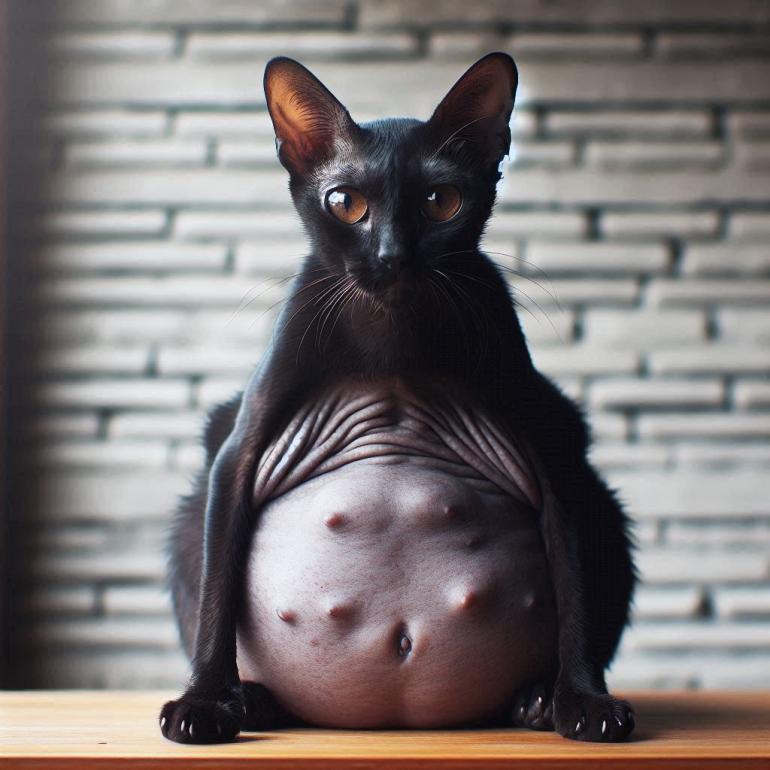Pyometra ('pyo' or womb infection)

Pyometra ('pyo' or womb infection)
Female cats and dogs that haven't been neutered often get pyometra, which needs major surgery to treat. It is possible for many animals to get better with treatment, even if their health is very bad. The best way to keep your female pet safe from pyometra is to have her neutered.

What is pyometra?
Pyo = pus, infection; metra = womb or uterus
Pyometra is a dangerous illness of the womb that makes pus, an infectious fluid, build up inside the organ. It usually shows up in female dogs and cats that are older and haven't had their teeth cleaned.
You can put pyometra into one of two groups: closed or open. A common sign of open pyometra is vaginal discharge. The color of this fluid could be yellow, cream, or red. In closed pyometra, there is no release from the outside. Your dog could get toxemia, or blood poisoning, if the pus doesn't leave the vagina. This can make them very sick. This chemical is harmful to the body and can lead to life-threatening diseases like kidney failure. It also hurts other body systems and organs. If you don't treat pyometra, it can kill you because of kidney failure, toxins, and dehydration.
A less common problem called stump pyometra happens in female cats that have been spayed or neutered. In these cats, a small part of the womb remains and gets infected. Even though the signs are generally not as bad because there is less womb, they still need to be treated to avoid problems.
What causes pyometra?
A female experiences all the hormonal changes linked to pregnancy whenever she has a season, which happens around twice a year, regardless of whether she is actually pregnant or not. With each cycle, the womb undergoes changes that increase the likelihood of infection with age. E. coli is a highly prevalent bacteria that typically causes infection. The illness frequently strikes during the weeks or months that follow a heat wave or season. The chance of getting pyometra can also be increased by hormone injections used to treat other illnesses or to halt seasons.
What are the signs of pyometra?
To be clear, pyometra only happens to women because men don't have wombs. It happens more often in girls older than 6 years old. Most of the time, the signs show up six weeks after the female's last period. The first signs of Pyometra might not be very obvious. It's possible that your pet is licking her behind more often than usual. Her color or food might not be right. She gets very thirsty a lot of the time and may get wet in the house from drinking so much. Sometimes there is a yellow or reddish-brown fluid at the vulva, which is where the pus from the womb has come out. As her illness gets worse, she may throw up, get very angry, and refuse to get out of bed.
It's likely that the symptoms will get worse over a few days to a few weeks. If symptoms are left ignored, they can lead to dehydration, collapse, and toxic shock death.
How will my vet know what is wrong with my pet?
Your vet will probably have a good idea of what's wrong with your pet based on the signs you describe, but they may need to do more tests to be sure of the diagnosis and that your pet is healthy enough to have surgery. To find out if the infection's toxins have entered the blood and could be hurting other organs, blood tests may be done. Ultrasound and X-ray tests can be used to see if the uterus is getting bigger.
Is there any treatment for pyometra?
If the diagnosis is correct, you should have your pet's belly taken out as soon as possible. Most of the time, a female cat or dog is spayed or neutered using the same method. However, there is a lot more risk when the animal is sick with pyometra. If you don't operate, there is an even bigger risk that most of the animals will die. If the womb is not taken out, the illness's poisons get into her bloodstream and make her situation worse. These poisons could finally cause the kidneys to stop working.
Your vet may decide that your pet needs to be given antibiotics and fluids through an IV before the operation. Your vet may decide to delay the surgery by 12 to 24 hours so that he or she has time to get your pet better so that it can handle it. She might need to stay in the hospital to get more care after the surgery.
Occasionally, injections of certain hormones have been used to treat cats in order to induce womb emptying without the need for surgery. Unfortunately, this treatment is rarely effective and is only thought to be an option for valuable breeding females.
Euthanasia might be the most humane choice for very old animals with pyometra and obvious signs of organ failure (such as kidney and liver failure), or if other critical issues like severe heart disease present.
Will my cat get better?
Pyometra is a dangerous illness, and it's sad that some people may not get better even after treatment because of symptoms and organ failure. There are a lot of dogs and cats that do get better, so getting help is definitely worth it.
If your pet heals from the surgery, she will probably be as healthy as she was before. People who own cats or dogs say that their pets are doing better than they have in a long time after the process. The animal might not have become really sick until the sickness had been there for a while.
How can I stop my cat getting pyometra?
The only way to be sure that your pet won't get this disease is to have her neutered. If you don't want her to have kittens, you should get her spayed or fixed right away. Not only does this solve all problems with reproduction, but removing a female during her first season also keeps her from getting breast cancer in the future. Check with your vet to find out when the best time is to neuter your pet.
Pyometra doesn't just happen to female cats that haven't been spayed or neutered or who have never had kittens, though it may be more common in these groups of cats. It is not a good idea to encourage careless breeding of cats and dogs as pets because it doesn't protect people.





